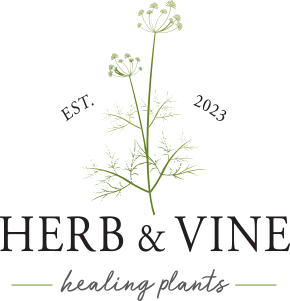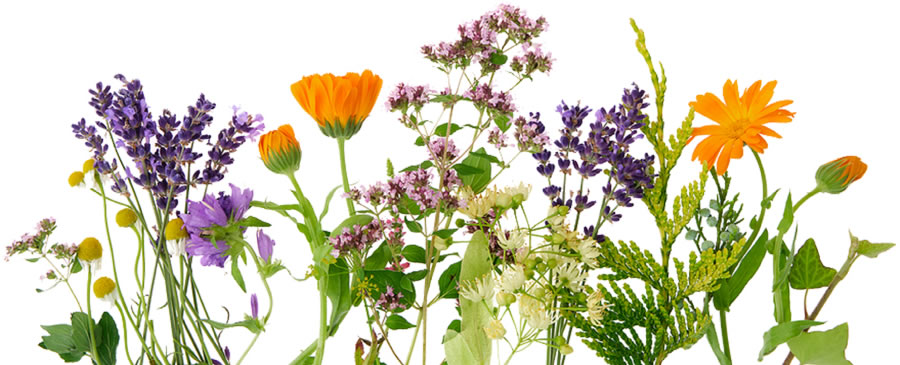Developing your own natural medicine cabinet is a rewarding experience whether you suffer from a chronic or acute condition, or even if you’re just looking to keep the basic remedies on hand. Choosing to limit or totally avoid pharmaceuticals is a brave move, but you can do it if you take the time to research the plants you’ll need for the specific treatments you’re looking to stock for.
Your natural medicine cabinet can either be purchased or produced. By that I mean, you can source and purchase ready-made teas, tinctures, salves, and ointments, or you can make them yourself. When it comes to producing your medicines, you have options here too. For convenience, you could buy the plant material; or if you’re good at identifying and have woods and meadows nearby, you could forage the plant material; lastly, you can grow your own plant material.
I have done all three. Recently I purchased some dried Burdock root for a salve. Also, I typically forage in my yard for dandelion and plantain (both of which are super easy to identify). And of course, since Herb & Vine Healing Plants is all about growing your own medicinal herbs and plants, so I do that as well.
Utilizing Buzz Buttons
Today, I harvested a plant grown from seed – Toothache Plant. Also called Spilanthes (Acmella oleracea) this is a species of flowering herb in the Asteraceae family. Both the leaves and the flowers of Toothache Plant (aka Buzz Buttons) are used as a natural anesthetic (you can chew on the fresh plant material to experience a tingling and numbing sensation). Since Spilanthes is frost sensitive, I wanted to have a remedy on hand that will last through many winters to come, indicating a tincture. Tinctures are concentrated extracts made by soaking plant material: bark, berries, dried or fresh leaves, and/or roots in a substrate. Typically I use alcohol, but you could use vinegar or glycerin.
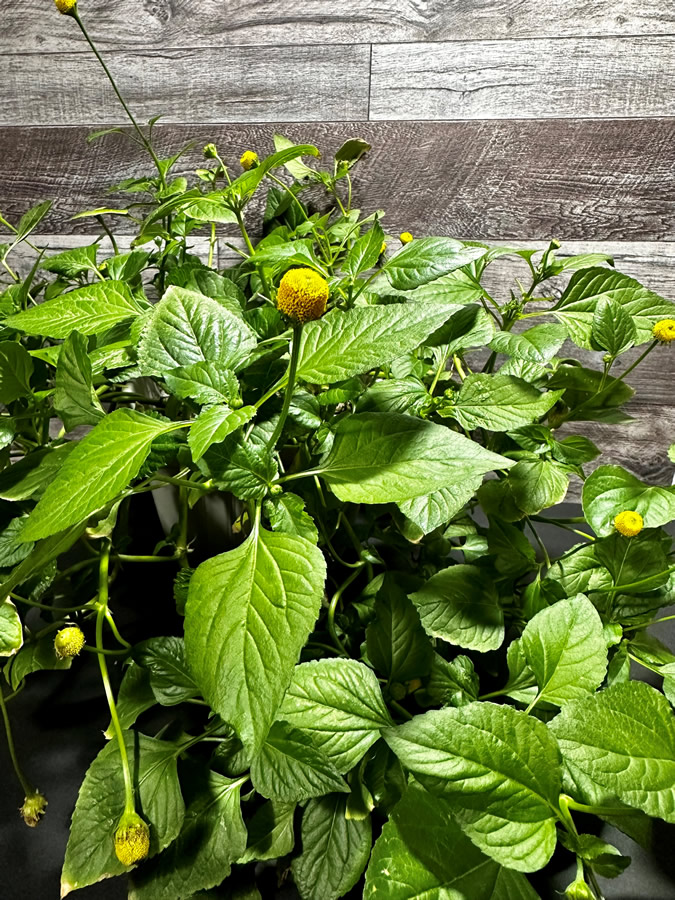
Spilanthes, or Toothache Plant, is an annual that has been used for generations for toothaches as it provides a numbing sensation.
The result will be a strong antibacterial solution that will last up to ten years if stored properly. Spilanthes also has anti-inflammatory and anti fungal properties which fight oral bacteria, combat skin fungi (ringworm and athlete’s foot), improve skin tone, and boost the immune system. The bitterness of the plant induces saliva production, making it useful for dry mouth and digestion.
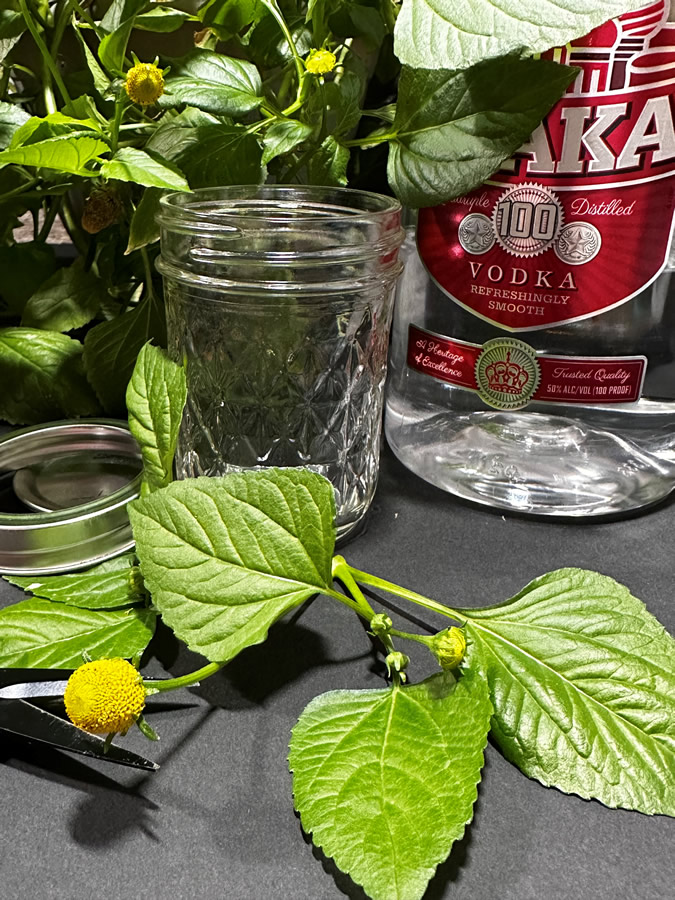
Gather your ingredients and equipment before starting the recipe below.
Here’s my basic Tincture Recipe… it’s easy-peasy!
Folk Method Tincture Recipe (for Spilanthes)
Ingredients:
– Fresh or dried plant matter*
– 100 proof Vodka or Everclear**
Equipment:
– Knife/cutting board or food processor
– Glass mason jar (half pint or pint) with lid
– Waxed or parchment paper
– Amber glass bottle for storage
– Labels
Start by clipping healthy, fresh flowers and leaves from your Spilanthes plant (if you don’t have fresh flowers, you can use dried). For fresh herbs, use a 1-1 plant-to-alcohol ratio. For dried herbs, use a 1-4 plant-to-alcohol ratio. If you’ve foraged the plant material, go ahead and rinse it with cool water and pat dry. If using root material, be sure to wash and gently scrub off any dirt.
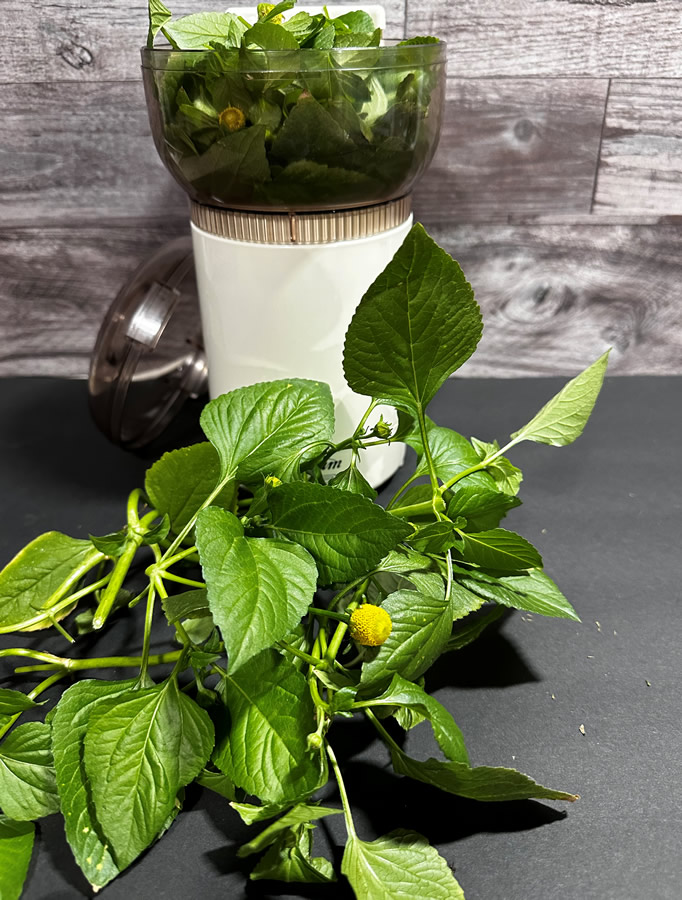
Using a food processor makes fast work of macerating your plant material in preparation for extraction.
Next, chop or macerate the material in a food processor. Chopping increases the amount of surface area for the alcohol to act upon.
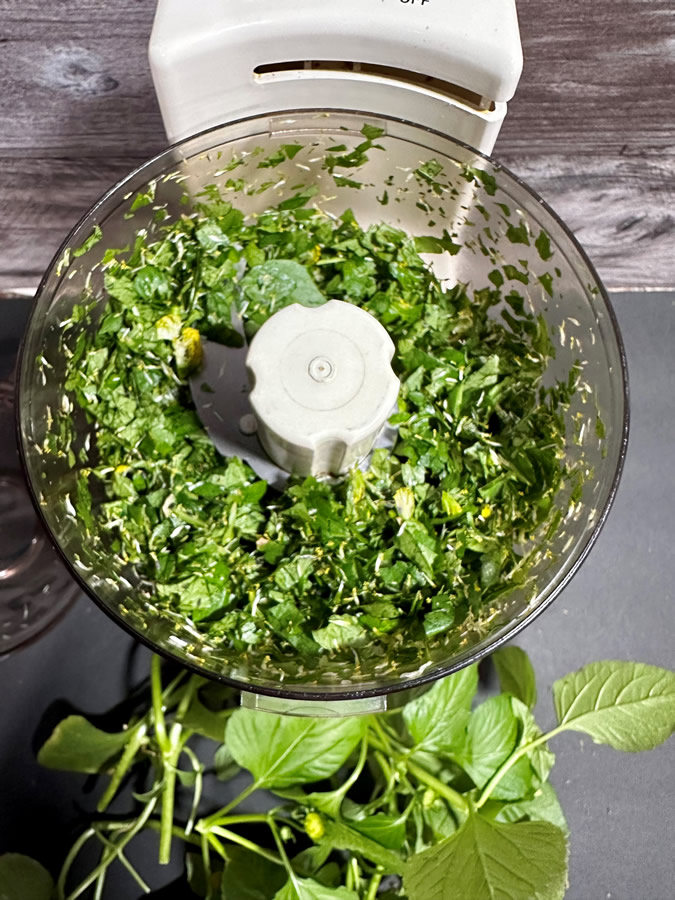
Don’t over process your plant material but chopping allows the alcohol to access more surface area.
Place the chopped material into a glass canning jar, filling it to the top. You can push it down, but don’t force it. You want the plant material to flow freely in the substrate.
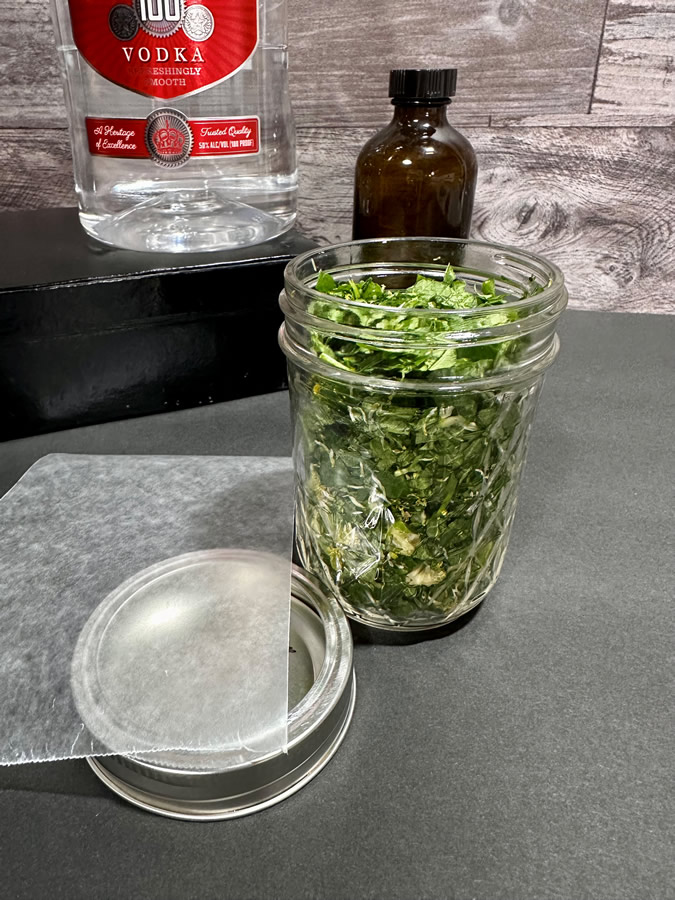
Fill your glass jar nearly to the top with fresh plant material after macerating.
Pour in enough vodka to cover the plant material by 1/2 to 1 inch.
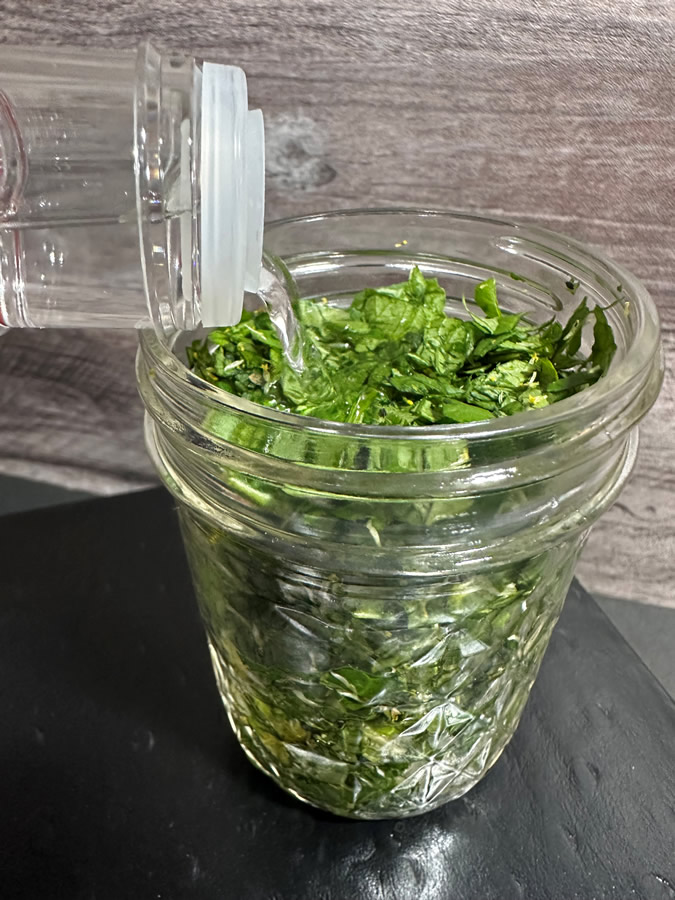
Add your solvent – in this case I’m using 100 proof alcohol… and yes, I bought the cheapest brand
Then cut a piece of waxed or parchment paper and top with a lid.
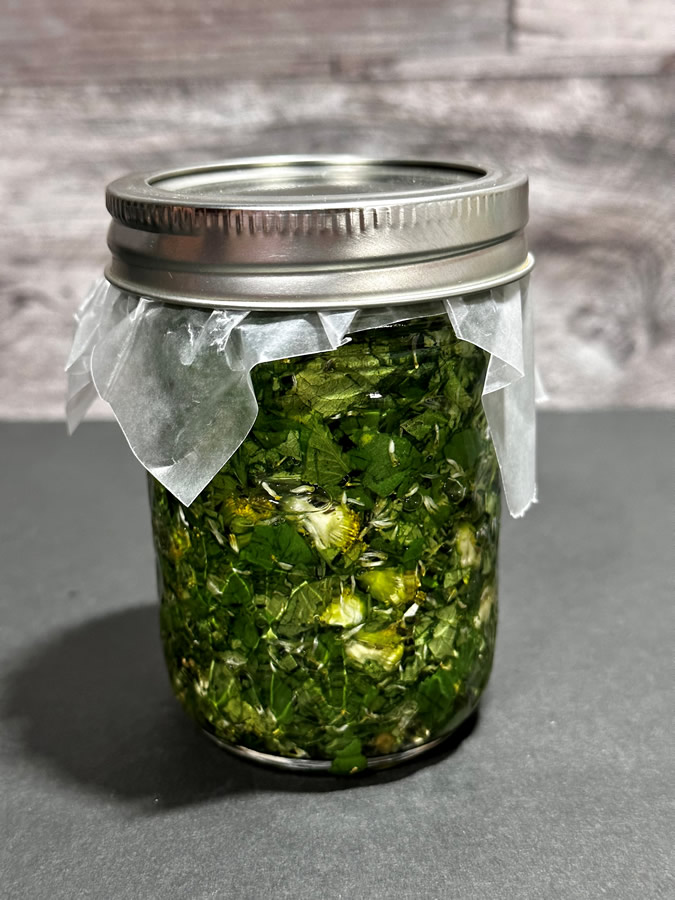
If using alcohol or vinegar, add a piece of waxed paper or parchment under the lid to protect the rubber seal.
Label the jar! Be sure to add the plant name, medicine style (tincture), and date made. Then give the jar a shake before storing in a cool dark place – like on a shelf in the basement or inside a cabinet. Shake the jar every day or so, or as often as you remember to, and allow it to infuse for 4 to 6 weeks.
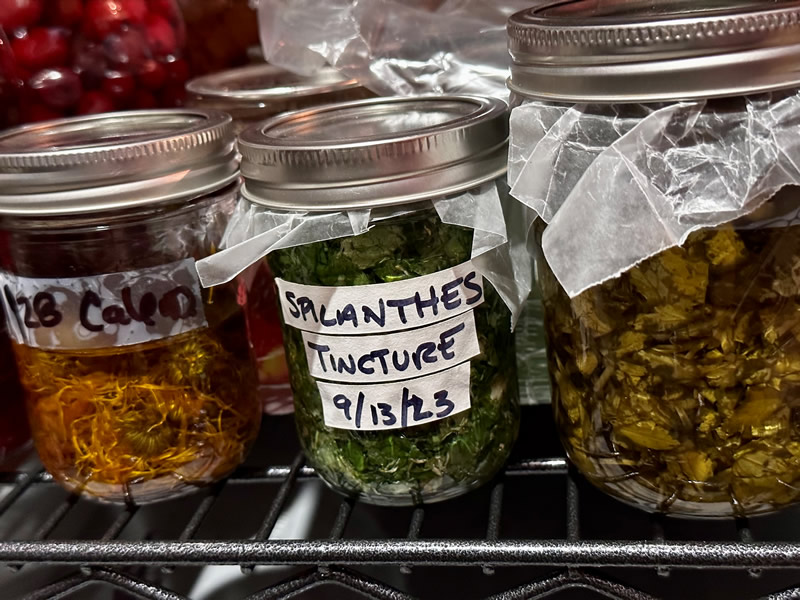
Be sure to clearly label your jar with plant name, type of process and date.
Strain the tincture two to three times to remove all the plant material (not pictured). I usually start with straining through a metal strainer. Then I filter again using a coffee filter or muslin. It’s important to remove all the plant material as leaving solids in your tincture may lead to mold growth.
The Finished Product
Once you’ve strained, pour the tincture into amber bottles (with or without dropper tops). Again, be sure to label them! Don’t assume you’ll remember – because if you’re like me…you won’t! Add the bottle(s) to your herbal medicine cabinet, which should be away from direct sunlight and heat.

Store tinctures in amber glass bottles away from sunlight and heat. Be sure to label them!
What are the best plants for tinctures?
Honestly, the very best tinctures are those you need and will use! And I feel the best quality tinctures come from the plants you grow. The peace-of-mind that comes from growing your own medicinal plants, then processing them into medicine for you and your family is priceless! Plus, tinctures made with high-quality ingredients make trustworthy solutions for relief from symptoms.
If you are looking for an all-natural way to improve your health, you should consider starting your own medicinal garden.
Herb & Vine Healing Plants grows over 50 medicinal herbs in its Jasper, Georgia greenhouse. Our plants are sold locally at the Jasper Farmer’s Market (April-July), or by appointment (call or text me at 770-519-5173). Follow us on Instagram or Facebook.
*Note: the type of plant you’re tincturing dictates what part of the plant you use. For example, if making a Ginsing tincture, you’d be using the root, for Milk Thistle, you’d use the fruit, etc.
**Note: that if you are planning to take the tincture orally, you must use a type of ethyl alcohol like Vodka or Everclear, not isopropyl alcohol (rubbing alcohol). Some herbalists use white rum or brandy for their tinctures. Different herbs require different concentrations of alcohol to extract their active ingredients. The more water soluble, the lower the proof needs to be. You could buy different proof levels of vodka, or dilute the alcohol with water.
